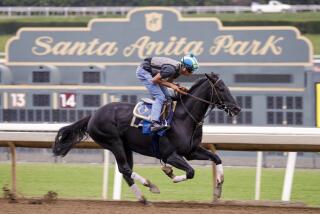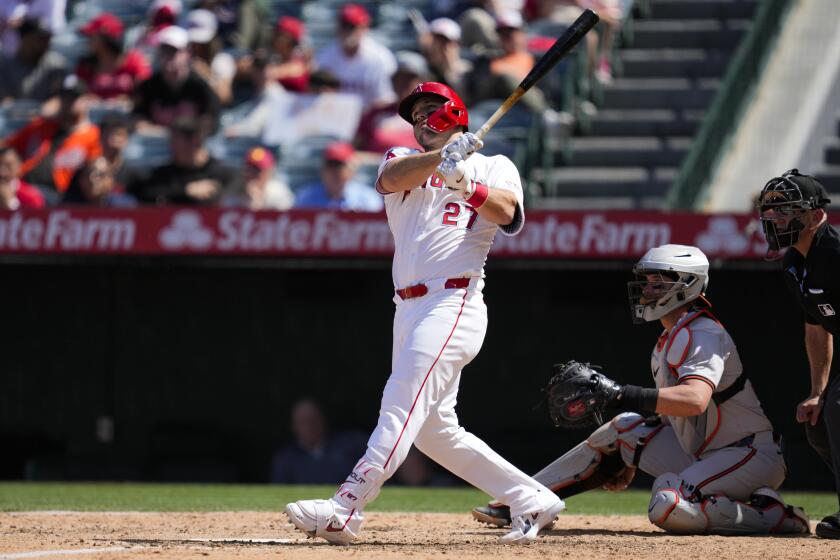Santa Anita faces a season of change that may make or break the 83-year-old track

Even by his own admission, Santa Anita’s top executive realizes the six-month meet that starts Tuesday may be the most critical in the track’s more than eight-decade history.
“We have to see the business turn around,” said Tim Ritvo, who was sent to Arcadia from the East Coast to try to revitalize the underperforming track for its owner, the Stronach Group. “This is the time some of the implemented changes will kick in. There is no silver bullet. It’s a grind process. We hope to see the trajectory in the right direction.”
On the eve of the track’s 83rd birthday — it opened on Christmas Day 1934 — Ritvo hit on many topics as to its future and the direction he wants to send it. Such as:
- The unexpected statistic that the group of trainers with five or fewer horses is the largest population on the track.
- The idea that anyone on staff who isn’t in sync with his mission may be without a job.
- The construction of up to 800 new barn stalls on the area currently a parking lot in back of the track.
- The three-day race week is currently off the table.
- And, he’s open to discussing an experiment of lower takeout, but only if the Thoroughbred Owners of California (TOC) and the off-track racing sites (ADWs) agree to cut their share, too.
When Ritvo arrived in May, he promised changes but only after he had time to evaluate how the track was running and who was running it. He always targeted the signature Winter-Spring meeting as the time when fans would start to see the difference.
It took just seconds to identify field sizes, which lead to lackluster mutuel handles, as the most immediate problem.
The concern was that even though there were plenty of horses, trainers and owners weren’t running them and instead using Santa Anita as a free training and stabling facility.
In a survey of the 155 trainers at Santa Anita, made public for the first time, 32% of them have five or fewer horses; 20% have between six and 10; 19% have between 11 and 20; and 29% have more than 20.
A lot of the trainers with small barns weren’t getting the kinds of races written for them. To answer that, the track is adding restricted maiden special weight races for horses that are homebred and sold at public auction for $100,000 or less. There also will be restricted claiming races for horses three years and older for trainers who have stalls of 20 horses or fewer.
“When trainers bring in their 2-year-olds, they get rid of older or lower claimers,” Ritvo said. “We need to make opportunities for those horses.”
Ritvo also made two high-level appointment in the past few weeks, sold as adding resources to needed areas, but clearly sending messages that those who may feel comfortable in their jobs need to pick things up.
Daniel Eidson, a veteran racing official, has been named racing director. While his appointment was said to be to help Rick Hammerle, vice president of racing, it will turn up the heat in the racing office if the fields aren’t full because of writing the wrong races.
“What I’m asking is that we look at every race that was written on that day last year, and make sure a better one is written this year,” Ritvo said.
Ritvo also named John Perrotta as vice president of operations. His job is to help increase the handle. Perrotta has spent time in both the racing and entertainment industries. He was one of the chief writers on the ill-fated HBO series “Luck”, filmed at Santa Anita.
“I want to see people here have the passion to resurrect this place to the glory that it should be,” Ritvo said. “Santa Anita should be the premium racetrack in America. If [the people here] believe in the mission, they will have a nice career, and if they don’t, they’ll need to find another place to work.”
So far, the only executive to exit Santa Anita was Joe Morris, senior vice president for West Coast operations of the Stronach Group. He served essentially as general manager and many of his duties were taken over by Ritvo.
There are also plans to add between 600 and 800 barn stalls to the back of the track. Once those are built there will be a transition from the old barns to the new ones, with the hope being that the old ones also would be rebuilt or refurbished in some way.
“We need to have stables for the smaller guys,” Ritvo said. “We’re meeting with the city to try and get the process going. This is not to make the big guys bigger, but to have someplace to introduce new trainers.”
Once construction starts it should take between six months and a year before the new stables are operational.
Shortly after Ritvo got here, he told The Times that it was more likely than not that the track would go to a three-day racing week.
“I’m confident that Rick [Hammerle] has done a good enough job that we can run four days a week,” Ritvo said. “That’s what we want. It’s about creating more for the customer than the horsemen. It all comes down to creating opportunities for the bettor.”
One obstacle that Ritvo did not anticipate is the formidable power of the TOC, which has the ability to block many initiatives related to racing and betting.
“We’re getting to understand each other,” Ritvo said. “For us to be successful, we have to move together as one business unit. I know I’m the new guy in town. Some people look at Gulfstream [where Ritvo revitalized the racino] and say how impressive it is. Others say we’ve cheapened the product.
“The part the TOC is missing is that lesser quality [non-stakes races] pay for stakes racing. The claiming races infuse money into the purse account. I just want to mix it in. … All I want is the TOC to have confidence and trust in me. And I hope they give me a chance to earn it.”
The purses are down about $600,000 this meeting. Ritvo called it a management review of what’s working and what’s not. The biggest hit is the Santa Anita Handicap, which went from $750,000 to $600,000. But the race known as the Big ’Cap has suffered greatly since it now competes with the $10 million Dubai World Cup.
There is a popular theory that if takeout, the amount the track cuts from the pot, were reduced, more money would be bet and it would more than offset the initial takeout loss with greater mutuel handles. It’s similar to the thinking of some parts of the latest government tax plan, except the people getting the extra money, the bettors, would essentially trickle-up to the track.
“Over time, as we work together, we can definitely review it,” Ritvo said. “The track cannot reduce takeout without the TOC agreeing. No one wants to try it in a [long] meet. But as the relationship grows, maybe we can try it in the 19-day meet. Let’s see how it works.”
Any way you look at it, Ritvo is trying to enlist change to aid a sport that is often very resistant to it.
“I’m not going to stick around for a paycheck; I want to accomplish something,” Ritvo said.
The clock starts on Tuesday.
More to Read
Get our high school sports newsletter
Prep Rally is devoted to the SoCal high school sports experience, bringing you scores, stories and a behind-the-scenes look at what makes prep sports so popular.
You may occasionally receive promotional content from the Los Angeles Times.







